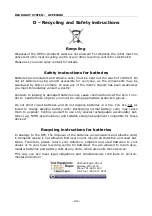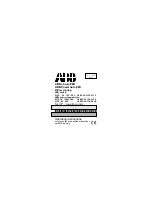
RP6 ROBOT SYSTEM - APPENDIX
Improved methods for distance- and positioning-measurements
Encoder measurements will never get 100% accurant. If you need better navigation,
you will have to use additional sensors.
For example, the University of Michigan in the USA designed a tiny trailer carrying the
encoder sensors for one of their big caterpillar-robots. The robot pulls the trailer,
which has been connected by a pivotable metallic rod. Encoder wheels at the trailer's
axles deliver accurate positioning data after performing a few calculations. Details
may be studied on the following website:
http://www-personal.engin.umich.edu/%7Ejohannb/Papers/umbmark.pdf
starting at page 20 (or page 24, respectively in the PDF-version)
http://www.eecs.umich.edu/~johannb/paper53.pdf
We might design a similar construction for the RP6 (though it will not be easy) – al-
ternatively you may consider to start some experiments by fixing an optical computer
mouse on the robot's rear or front. Additionally you could use an electronic compass
or similar devices, which will be mounted at the very top of the robot (to avoid inter-
ferences with the motors and other electronics) and enable accurate rotational move-
ments.
Of course a Gyro may be an alternative positioning sensor as well...
We did not test these ideas, which must be considered as thought provoking impulses
for further improvements and studies... and of course some users may not be inter-
ested in accurate movements anyway - adding a mouse sensor also restrains the
vehicle's offroad capabilities.
Basically perfect positioning requires the use of landmarks, which have to be posi-
tioned at accurately defined locations. Of course, these positions must be well known
and easily recognizable by the robot, e.g. infrared beacons transmitting a guidance
signal for the robot. The Robot can detect direction of the beacons.
Or you implement line tracing sensors for following markings on the floor.
As a matter of fact we might think of much more complicated positioning methods ...
but we will restrict this overview only to a few ideas requiring a minimal amount of
CPU power. We might install a camera to the ceiling and remotely control the robot by
special pattern-recognition software and transferring command data by wireless or in-
frared signals. Some users already managed to create a similar remote control system
for the small ASURO robot...
You will notice that it is easy to navigate the Robot relatively accurate by using a re-
mote control. Obviously accurate controlling is largely supported by visual feedback of
the user, who directly observes directions, obstacles and targets! The robot is unable
to see these details without cameras and powerful image processing. A camera at the
ceiling and a color marking on top of the robot would provide us with an external
sensor for more accurate visual feedback...
- 138 -


































